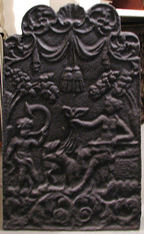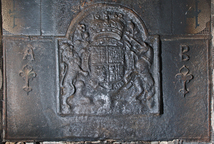-
868
Description: Rectangular with arched, mirrored scrolls on top and central scallop shell, below which are swagged drapes with a central tassel; fillet edging; in a grove, to the left a putto blowing a horn, to the right a semi-naked female figure seated, holding the tail of a fish, with two ?dogs at her feet; at the bottom, narrow panel with symmetrical scrolled foliate decoration.
Notes: Like others in the series, the scene is not immediately identifiable with a scene in classical mythology.
Copies of this fireback are known.
- Decoration tags:
- rectangular with ornate arch (shape)
- fillet (edging)
- whole carved pattern
- pictorial
- mythological
- animals
- humans
- plants
Manufactured: in the early-18th century in England.
Current location: Metropolitan Museum of Art, 1000, Fifth Avenue, New York, New York, United States of America.
Museum number: 08.81.6 (part of the Metropolitan Museum of Art, New York museum group)
- Attached to series:
- Late pictorial series (all)
- Late pictorial series 2
-
500
Description: Arched rectangular shaped central panel with astragal and fillet edge, pictorial, a bald, naked man, standing on a mound, holding a baton in his left hand, surrounded by leaf fronds to left and right, and clouds above; arched rectangular shaped border, fillet edging, hanging leaf clusters to left and right, swirled lines above, and draped foliage with monogram at base; on top are two serpents and draped foliage.
Notes: The figure may represent Pheidippides, the messenger between Athens and Sparta during the Battle of Marathon in 490BC.
Copies of this fireback are known.
Inscription: TAN
- Decoration tags:
- 'Dutch' (shape)
- fillet (edging)
- whole carved pattern
- pictorial
- mythological
- monogram
- text
- humans
Manufactured: in the early-18th century probably at Ashburnham Furnace in the Weald area of England.
Current location: West Berkshire Museum, Newbury, Berkshire, England.
Citation: Lloyd, N., 1925, 'Domestic Ironwork I', Architectural Review, 58, pp. 58-67.
- Attached to series:
- TAN series
- British 'Dutch' style firebacks
-
1144
Description: Composite; arched rectangular shaped, armorial fireback, cavetto edging, with Stuart Royal arms, garter, supporters, crown and motto, and 1662 date above crown; this overlies a rectangular plate with fillet edging; top centre in the space each side of the central shield, an initial letter - A to left, B to right - each above a fleur-de-lys, its stem terminating in a small buckle.
Notes: Several firebacks have incorporated the same Stuart royal shield, which probably originally dated to 1619, but with the date altered. A similar fireback, but without the initials and fleurs-de-lys, dated 1661, and reputed to have come from the Totsey, the old guildhall at the market cross in Gloucester, is illustrated in Ames, 1980, 23; possibly the same fireback was reported by the late David Bick to be at The Grange, Minsterworth, Gloucestershire (demolished in the late 1960s).
Inscription: 16 62 / [Garter motto (illeg.)] / A B
Arms: English Stuart royal
- Decoration tags:
- rectangular with round arch (shape)
- fillet (edging)
- carved stamps
- carved pattern panels
- composite
- individual letters
- heraldic
- armorial
- royal
- text
Manufactured: in 1662 possibly in the Forest of Dean area of England.
Current location: in private hands, Norton, Wiltshire, England.
Citation: Ames, A., 1980, Collecting Cast Iron (Ashbourne, Moorland Publishing).
Citation: Badeni, J., 22 Sep 1983, 'Whose Fireback?' [letter], Country Life, 174, 4492, p. 772.
-
1161
Description: Arched rectangular central panel with bead-and-pellet edging (top and sides); on a ground between two plants, their flowers upstanding, a gadrooned flower vase with two, scrolled handles, tulips and other flowers issuing from the narrow neck; arched rectangular border with fillet edging; mirrored descending flower swags; along a rectangular bottom panel with fillet edging a symmetrical arrangement of swirled foliage; on top, two mirrored sea serpents; at the sides, a narrow vertical extension bordered with a fillet and with bead infill; at the base, a plain extension panel.
Notes: The presence of tulips suggest a Dutch origin for the pattern of this fireback, although the presence of several examples in England suggest that it was produced there rather than on the Continent. One of several very similar designs, varied by the forms of the vases, the style of the flowers and by their dimensions. Copies of this fireback, without the extension at the bottom, were advertised in Kings Worthy Foundry's (Winchester) catalogue in the mid-20th century.
Copies of this fireback are known.
- Decoration tags:
- 'Dutch' (shape)
- fillet (edging)
- whole carved pattern
- extension panels
- pictorial
- plants
- objects
Manufactured: in the late-17th century in England.
Current location: not known.
- Attached to series:
- Flower Vase 'Dutch' types
- British 'Dutch' style firebacks
-
211
Description: Rectangular with arched, mirrored, scrolls on top, a cartouche scallop shell between; fillet edging; between two trees, three soldiers in Roman dress, holding either pikes, swords or shields, one on a plinth; at the bottom, a separate rectangular panel with mirrored scrolled foliage.
Notes: Possibly intended to represent the Horatii who, according to Livy, defeated the Curiatii.
Copies of this fireback are known.
- Decoration tags:
- rectangular with ornate arch (shape)
- fillet (edging)
- whole carved pattern
- pictorial
- mythological
- humans
Manufactured: in the early-18th century in England.
Current location: Kernow Furniture, Penhalvean Pottery, Penhalvean, Cornwall, England.
- Attached to series:
- Late pictorial series (all)
- Late pictorial series 4
-
509
Description: Arched rectangular central panel with astragal and fillet edging; Phaëton riding Apollo’s chariot across the skies, the sun to the left behind clouds, a lion on ground below, between two trees; arched rectangular border with fillet edging; trailing convolvulus leaves surround the central panel; on top, earl’s coronet above an illegible character, between mirrored, swirled foliage.
Notes: The illustration upon which the design has been based has not been identified, save that it figures in book II of Ovid's Metamorphoses. The convolvulus border is a common feature of this series of firebacks and can be compared with other. The wooden pattern from which this casting was made survives in the collection of the Sussex Archaeological Society (no. 928).
- Decoration tags:
- 'Dutch' (shape)
- fillet (edging)
- whole carved pattern
- planklines
- pictorial
- mythological
- animals
- humans
- objects
Manufactured: in the early-18th century at Ashburnham Furnace in the Weald area of England.
Current location: Penhurst Manor, Penhurst, East Sussex, England.
- Attached to series:
- TAN series
- British 'Dutch' style firebacks
-
510
Description: Arched rectangular central panel with astragal and fillet edging; to the left, Æneäs carrying his father, Anchises; to the right, an arched gateway and portcullis beneath battlements with flames rising therefrom; above left, clouds; far left, a tree; arched rectangular border with fillet edging; trailing convolvulus leaves surround the central panel; plain rectangular extensions to the bottom and each side; on top, mirrored, swirled foliage.
Notes: Many of the early illustrated editions of Ovid’s Metamorphoses show Æneäs escaping from burning Troy, with his father on his back, most of them with an archway in the background.
Copies of this fireback are known.
Inscription: TAN
- Decoration tags:
- 'Dutch' (shape)
- fillet (edging)
- whole carved pattern
- planklines
- extension panels
- pictorial
- mythological
- architectural
- monogram
- text
- humans
Manufactured: in the early-18th century at Ashburnham Furnace in the Weald area of England.
Current location: Penhurst Manor, Penhurst, East Sussex, England.
- Attached to series:
- TAN series
- British 'Dutch' style firebacks
-
516
Description: Arched rectangular central panel with bead-and-pellet edging; on a ground between two plants, a gadrooned flower vase with two, scrolled handles, tulips and other flowers issuing from the narrow neck; arched rectangular border with fillet edging; mirrored descending flower swags; along a rectangular bottom panel with fillet edging a symmetrical arrangement of swirled foliage; on top, two mirrored sea serpents.
Notes: The presence of tulips suggest a Dutch origin for the pattern of this fireback, although the presence of several examples in England suggest that it was produced here rather than on the Continent.
Copies of this fireback are known.
- Decoration tags:
- 'Dutch' (shape)
- fillet (edging)
- whole carved pattern
- planklines
- pictorial
- plants
- objects
Manufactured: in the late-17th century in England.
Current location: Penshurst Place, Penshurst, Kent, England.
- Attached to series:
- Flower Vase 'Dutch' types
- British 'Dutch' style firebacks
-
545
Description: Arched rectangular central panel with canted top corners and bead-on-fillet edging; pictorial scene of Jesus at the well with the woman of Samaria; arched rectangular border with fillet edging; on top, central scallop shell with a descending dolphin on each side of the arch.
Notes: A scene from the New Testament - John 4. Mitford Collection, Petworth House.
Copies of this fireback are known.
Manufactured: in the mid- to late-17th century in the Siegerland area of Germany.
Current location: Petworth House, Petworth, West Sussex, England.
Museum number: NT/PET/M/100 (part of the National Trust museum group)
- Attached to series:
- 'Dutch' Miscellaneous Firebacks
- New Testament firebacks
-
548
Description: Arched rectangular central panel with bead edging; female figure, a crown above her head, holding two snakes; arched rectangular border with fillet edging; top centre, knot of ribbon with festoons of pomegranates suspended therefrom via a ring on each shoulder of the plate; at the bottom, two crossed palm fronds; on top, symmetrical arrangements of swirled foliage; on each side, a plain rectangular panel with fillet edging.
Notes: Possibly the allegorical figure of Democracy; the form of the palm fronds and the swirled foliage on top suggest a common pattern-maker with the TAN series and the Mayfield 'Dutch' series. Mitford collection, Petworth House.
- Decoration tags:
- 'Dutch' (shape)
- fillet (edging)
- whole carved pattern
- extension panels
- pictorial
- allegorical
- humans
Manufactured: in the early-18th century in England.
Current location: Petworth House, Petworth, West Sussex, England.
Museum number: NT/PET/M/102 (part of the National Trust museum group)
- Attached to series:
- British 'Dutch' style firebacks
- TAN series









